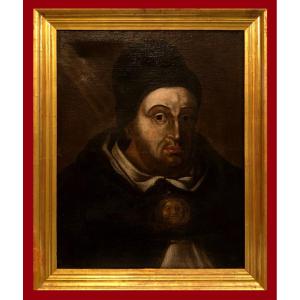Only the playful attention of a small dog suggests anything less than patrician dignity. Symbolism was important in portraiture and it provided a pointed and aspirational narrative that would not have been lost on contemporary viewers. For example, the presence of the dog, which was likely the boy’s pet, is at once a charming pictorial device and also a clear allusion to fidelity, trust and loyalty.
The hairstyle and the attire, notably the type of cravat with the blue ribbon, help to date this portrait to between 1670 to 1685. Until the late eighteenth century children were dressed as adults - boys were dressed like men in breeches, vests, and coats between four and seven years of age. The expensive lace is an indication to his family’s wealth.
Held in a good quality and condition antique gilded frame.
Born in Suffolk, Mary Beale, nee Cradock (1633-1699) was employed by many of the most distinguished persons of her time including nobility, landed gentry, and clergymen. Technically accomplished, her paintings are noteworthy for their honest and sympathetic portrayal. In 1651 she married Charles Beale, who shared her interest in art, and thus the Beale studio was a partnership between husband and wife. While Mary painted, Charles provided practical support. He primed canvases, procured art supplies from merchants, manufactured expensive, high-end pigments such as red lake and ultramarine (some for sale to other painters), and kept the books. He also left detailed notebooks about his wife’s daily activities; such as her commissioned portraits as well as the experimental studies. For the latter, he identifies the sitters and, in most cases, their poses and tracks the progress of each work from one sitting to the next, paying particular attention if a novel technique had been used. The Beale's purpose in carrying out the studies, as well as to develop skills, was to test out, various painting methods. Together they sought to improve the studio's efficiency, through perfecting procedures that would produce good results at a lower cost. These accounts of the daily activities are an incredibly valuable insight into the working practices of her studio. In fact, we know more of her technique and working practice than that of many of her contemporaries, including Sir Peter Lely.
By the late 1650s, Beale had developed a formidable reputation and befriended Sir Peter Lely, the leading artist of the Restoration and court painter to Charles II, King of England. She observed Lely in his studio—a rare privilege—and copied many of his portraits, modelling her technique after his. Lely would visit the Beale home occasionally to observe Mary paint and praise her work and Lely loaned Beale some of his old master paintings to copy from.
During her childhood in Suffolk Mary's father was friendly with contemporary British artists such as Sir Nathaniel Bacon, Robert Walker, and Sir Peter Lely, leading to both Robert Walker and Peter Lely being "the most likely drawing masters to the young Mary". Even though Beale occasionally adapted some of Lely’s poses it is not known for certain with whom she studied; Lely encouraged her in her efforts but there is no evidence that he actually instructed her. However, her father was an amateur artist and seems the most likely candidate to have shown her how to draw and paint.
She was exceedingly industrious and experimented with many new materials and techniques. She often employed the use of an elaborate stone cartouche that surrounded her sitters and by the 1670s, the couple’s two young sons Charles and Bartholomew, were assisting his mother in her painting studio in Pall Mall, executing feigned stone cartouches in head and shoulder portraits as well as painting drapery.
In 1672 she earned £202 for her commissions, and in 1677 she had 83 commissions, earning £429, a considerable sum. She also took students, many of them women, including Keaty Trioche and Sarah Curtis. All proof that Mary was earning her living and supporting her family with her art which was a highly unusual position for a woman at the time.
Provenance: The Flower family at Hill House, Stratford-upon-Avon; thence by decent
The Flower family were a prominent family in Stratford upon Avon, having established a brewery there in 1833. Edward Fordham Flower was one of the largest employers in the town, whose interests the family had very much at heart: four generations in turn became Mayor. His sons were Edgar and Charles. In the 1870's Charles Flower gave land and £1,000 to launch a fund to build the Shakespeare Memorial Theatre - and as Mayor on Shakespeare's Birthday, 23 April 1879 had the privilege of opening a beautiful High Victorian playhouse of intricate brickwork and castle features. Shortly afterwards, he initiated measures to transform the Bancroft into a pleasure garden for townsfolk - as it remains to this day.
In the 1890's his brother Edgar brought the medieval grammar school buildings back into a proper state of repair and restoration. An aunt continued the philanthropic tradition, caring not only for all of the many nieces and nephews, but also for employees and townsfolk and their children, even to the extent of purchasing numerous grave spaces at the newly opened municipal cemetery in Evesham Road, to lessen the fear of a pauper's burial.
Sir Archibald Flower, (Mayor in 1932), maintained the family theatrical involvement, and oversaw the fund-raising for the re-building of the Shakespeare Memorial Theatre, opened that same year.
Measurements: Height 90cm, Width 82cm, Depth 8cm framed (Height 35.5”, Width 32.25”, Depth 3.25” framed)


























 Le Magazine de PROANTIC
Le Magazine de PROANTIC TRÉSORS Magazine
TRÉSORS Magazine Rivista Artiquariato
Rivista Artiquariato
